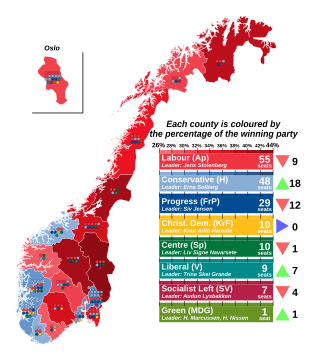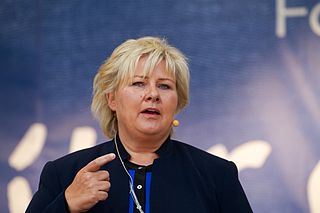The politics of Norway take place in the framework of a parliamentary, representative democratic constitutional monarchy. Executive power is exercised by the Council of State, the cabinet, led by the prime minister of Norway. Legislative power is vested in both the government and the legislature, the Storting, elected within a multi-party system. The judiciary is independent of the executive branch and the legislature.

The Labour Party, formerly The Norwegian Labour Party, is a social-democratic political party in Norway. It is positioned on the centre-left of the political spectrum, and is led by Jonas Gahr Støre. It was the senior partner of the governing red–green coalition from 2005 to 2013, and its former leader Jens Stoltenberg served as the prime minister of Norway.

The Christian Democratic Party is a Christian-democratic political party in Norway founded in 1933. The party is an observer member of the European People's Party (EPP). It currently holds three seats in the Parliament, having won 3.8% of the vote in the 2021 parliamentary election. The current leader of the party is Olaug Bollestad.

The Socialist Left Party is a democratic socialist political party in Norway. Positioned on the left-wing of the political spectrum, it is opposed to European Union and the European Economic Area membership. SV supports a strong public sector, stronger social welfare programs, environmentalism, and republicanism. As of 2018, the party had 11,385 members; the number has steadily increased since a low point in 2015. The party leader is Kirsti Bergstø, who was elected on 18 March 2023

The Centre Party, formerly the Farmer's Party, is an agrarian political party in Norway.

Erna Solberg is a Norwegian politician and the current Leader of the Opposition. She served as the 35th prime minister of Norway from 2013 to 2021, and has been Leader of the Conservative Party since May 2004.
The Conservative Party or The Right is a liberal-conservative political party in Norway. It is the major party of the Norwegian center-right, and was the leading party in government as part of the Solberg cabinet from 2013 to 2021. The current party leader is former Prime Minister Erna Solberg. The party is a member of the International Democrat Union and an associate member of the European People's Party.

Parliamentary elections were held in Norway on 11 and 12 September 2005. The result was a victory for the opposition centre-left Red-Green Coalition, which received 48.0% of the votes and won 87 out of 169 seats, dominated by the Labour Party's 61 seats. The three-party centre-right government coalition won 44 seats and the right wing Progress Party won 38, becoming the largest opposition party. Voter turnout was 77.1%, an increase of 2 percentage points compared to the 2001 elections.
The red–green coalition was a centre-left coalition of parties in Norway, constituting the Labour Party (Ap), the Socialist Left Party (SV), and the Centre Party (Sp). Unlike many other Red-Green coalitions, the "green" here was the colour of a centrist eurosceptic Nordic agrarian party rather than an actual green political movement. It governed from 2005 until Labour Party leader Jens Stoltenberg resigned his cabinet on 16 October 2013 following the coalition's defeat in the 2013 elections.

Jonas Gahr Støre is a Norwegian politician who has served as the 36th and current Prime Minister of Norway since 2021 and has been Leader of the Labour Party since 2014. He served under Prime Minister Jens Stoltenberg as Minister of Foreign Affairs from 2005 to 2012 and as Minister of Health and Care Services from 2012 to 2013. He has been a Member of the Storting for Oslo since 2009.

Trygve Magnus Slagsvold Vedum is a Norwegian politician who has served as Minister of Finance since 2021. A member of the Centre Party, which he has led since 2014, he has been a Member of Parliament (MP) for Hedmark since 2005. Vedum also served as Minister of Agriculture and Food from 2012 to 2013.

Stoltenberg's Second Cabinet was the Government of Norway from 17 October 2005 to 16 October 2013. It was a coalition between the Labour Party, the Socialist Left Party and the Centre Party, known as the Red–Green Coalition. On 9 September 2013, the coalition was defeated in the 2013 election.

Parliamentary elections were held in Norway on 13 and 14 September 2009. Elections in Norway are held on a Monday in September, usually the second or third Monday, as determined by the king. Early voting was possible between 10 August and 11 September 2009, while some municipalities also held open voting on 13 September. Voters elected 169 members for the Storting, each for a four-year term. Voter turn-out in the 2009 general elections was 76.4%.

Parliamentary elections were held in Norway on 8 and 9 September 2013 to elect all 169 members of the unicameral Storting. The centre-right coalition obtained 96 seats, while the incumbent red–green coalition government obtained 72 seats and the Green Party obtained one. The Labour Party won the largest share (30.8%) of the votes cast, with the Conservatives coming second (26.8%), after increasing its share by 9.6 percentage points.

Olaug Vervik Bollestad is a Norwegian nurse and politician for the Christian Democratic Party who is a member of Parliament for Rogaland since 2013 and party leader since 2021, having been deputy leader from 2015 to 2021. She served as Minister of Agriculture and Food from 2019 to 2021.

The Solberg Cabinet was the government of the Kingdom of Norway, headed by Conservative Party leader Erna Solberg as Prime Minister from 16 October 2013 to 14 October 2021. The government was appointed by King Harald V on 16 October 2013 following the parliamentary election on 9 September, consisting of the Conservative Party and the Progress Party as a minority government. On 16 December 2015, the cabinet was re-shuffled. The government secured renewed support following the 2017 parliamentary election. It was expanded on 14 January 2018, when an agreement was reached to include the Liberal Party, and further expanded on 22 January 2019 when the Christian Democratic Party joined the coalition. On 20 January 2020, the Progress Party announced that it would withdraw from the government, citing the decision to bring home the family of a sick child from Syria, which included the child's mother, a Norwegian citizen who had volunteered for the Islamic State.

Parliamentary elections were held in Norway on 11 September 2017 to elect all 169 members of the unicameral Norwegian Parliament, the Storting. The non-socialist parties retained a reduced majority of 88 seats, allowing Prime Minister Erna Solberg's Conservative-Progress coalition to remain in government. The Liberal Party joined the coalition in January 2018 but it remained a minority cabinet until the Christian Democratic Party joined the coalition in 2019. The three largest centre-left parties won 79 seats. The Green Party retained its single seat, while the Red Party won its first ever seat.

Sigbjørn Gjelsvik is a Norwegian politician for the Centre Party. He was elected to Parliament in 2017. He also served as minister of local government from 2022 to 2023.

The 2023 Norwegian local elections were held on 11 September 2023. Voters elected representatives to municipal and county councils, which are responsible for education, public transportation, healthcare, elderly care, waste disposal, the levy of certain taxes, and more. All council seats were up for election across the 15 counties and 357 municipalities of Norway.





























